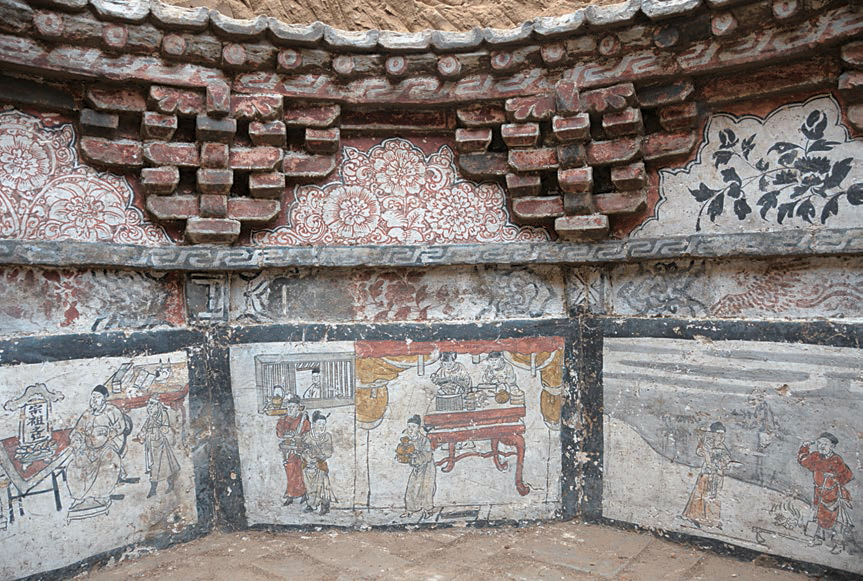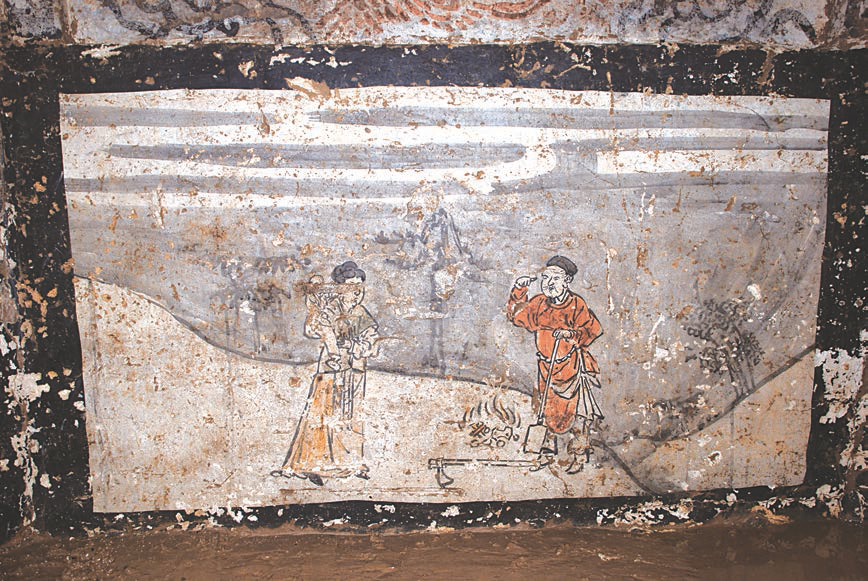Ancient Octagon-Shaped Tomb Reveals Morbid Tales from Mongol-Ruled China

Archaeologists in Yangquan, China, have discovered an octagon-shaped tomb with walls covered in murals that dates back some 700 years, when the descendants of Genghis Khan ruled China.
The pyramid-shaped roof of the tomb is decorated with images of the sun, moon and stars, archaeologists said. And one of the murals depicts the story of parents attempting to bury their young son alive.
Seven of the walls are covered in murals, while the eighth holds the entranceway. No skeletal remains were found inside, though a mural on the north wall shows the tomb's husband and wife occupants, a team of archaeologists wrote in a report published recently in the journal Chinese Cultural Relics. [See Photos of the Octagon-Shaped Tomb and Excavation]
Some of the murals show scenes of life in Mongol-ruled China. These include a band of musicians playing songs, tea being prepared, and horses and camels transporting people and goods, according to the paper.
Some of the people in the murals are shown wearing Mongol, rather than Chinese, fashion styles, the archaeologists noted. For instance, in one mural, a camel is being led by a man who "is wearing a soft hat with four edges, which was the traditional hat of northern nomadic tribes from ancient times," the archaeologists wrote in the journal article.
"Mongol rulers issued a dress code in 1314 for racial segregation: Han Chinese officials maintained the round-collar shirts and folded hats, and the Mongolian officials wore clothes like long jackets and soft hats with four edges," they wrote.
Ancient Chinese stories
Two of the murals depict stories that were popular throughout Chinese history. One shows the story of Guo Ju and his wife, who have a young son and are caring for Ju's sick mother. The family is short of food and money, and must choose between caring for the mother or the child. They decide to bury their child alive so that they can afford to feed Ju's mother and buy her medicine. When they are digging a hole, they discover numerous gold coins — a reward from heaven for caring for the mother. They no longer need to sacrifice their son, and the family lives happily ever after, according to this mural. [In Photos: Ancient Tomb of Couple Found in China]
Sign up for the Live Science daily newsletter now
Get the world’s most fascinating discoveries delivered straight to your inbox.

Another mural depicts the story of Yuan Jue, a child who insisted that his grandfather be cared for properly. In the story, Jue's family is living through a period of famine, and Jue's father decides to bring Jue's grandfather out into the wilderness so that he will die and the other family members will have a better chance of survival. Jue protests, following his father (who is carting his grandfather away), saying that if he goes through with his actions, Jue will cart his father into the wilderness when he is older. The father relents, and the family (grandfather included) makes it through the famine.
While these two stories may sound grim, both depict "filial piety," the importance of respecting your parents and grandparents and caring for them when they get older, the researchers noted.
Such stories were popular throughout Chinese history, wrote Alan K. L. Chan and Sor-hoon Tan in the introduction to the book "Filial Piety in Chinese Thought and History" (Routledge, 2004). "There is near unanimity among early Chinese thinkers about the importance of xiao [a word that means "filial piety"] in the Chinese ethos," wrote Chan, who is a professor at Nanyang Technological University in Singapore, and Tan, who is a professor at the National University of Singapore. "Among the various forms of virtuous conduct, xiao [filial piety] comes first, declares a well-known Chinese proverb."
Mongol rule
A Mongol force led by Kublai Khan, the grandson of Genghis Khan, conquered China in 1271. At the time, the Mongols also controlled Mongolia and parts of modern-day Russia, Korea and Vietnam. The descendants of Genghis Khan ruled China until 1368, when rebel soldiers forced the Mongols to retreat to Mongolia. During their rule, the Mongols constructed Shangdu (also known as Xanadu), which the Mongol rulers used as their capital during the summertime.
The period of Mongol rule coincided with the Little Ice Age, a global climatic event in which the weather in Europe and Asia was cooler, Timothy Brook, a history professor at the University of British Columbia, wrote in his book "The Troubled Empire: China in the Yuan and Ming Dynasties" (The Belknap Press of Harvard University Press, 2010).
At times the people suffered at times due to flooding and famine in China during Mongol rule, although sometimes the economy prospered, Brook wrote. According to historical records, there was an increase in "dragon" sightings in the decades before the Mongols left China, Brook noted, with one dragon supposedly destroying 3,200 acres (1,300 hectares) of farm fields in 1339. Today, dragons are regarded as mythical and what people were actually seeing is not clear. Despite the historical claims of dragon attacks during the time of Mongol rule, no depictions of dragons were found in this tomb.
The tomb was discovered in April 2012 and was excavated by a team of archaeologists from Yangquan City's Office of Cultural Heritage Administration and the Bureau of Cultural Relics and Tourism of the Suburbs of Yangquan City. Their report was first published in Chinese, in the journal Wenwu in 2016, and was recently translated into English and published in the journal Chinese Cultural Relics.
Originally published on Live Science.

Owen Jarus is a regular contributor to Live Science who writes about archaeology and humans' past. He has also written for The Independent (UK), The Canadian Press (CP) and The Associated Press (AP), among others. Owen has a bachelor of arts degree from the University of Toronto and a journalism degree from Ryerson University.









